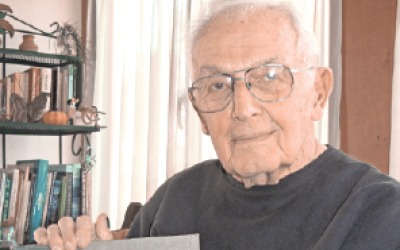
Frank Massimo is now 94, but the Albertson resident still hasn’t given up on the receiving the Purple Heart he believes he earned when he was injured while commanding a minesweeper off the French Coast during World War II.
“I’m disappointed and frustrated,” Massimo said of his recent efforts to receive recognition.
But, he said, he has not given up.
Massimo, who moved to Alberton in 1952 and raised a son and a daughter there with his wife Gloria, said it did not occur to him until last year that he was eligible for the Purple Heart commendation when he read online that any injury sustained from a sea mine was a viable claim.
He said he then sent the documentation he had on his injury to the U.S. Navy and Marine Corps Board of Correction of Naval Records in January 2012, which told him to send his documents Navy Personnel Command in St. Louis.
The Navy, he said, he has yet to receive a reply.
Massimo had only been commanding a minesweeper off the French coast for a few weeks in April 1945 when his ship was rocked by a mine.
“All of a sudden, I saw the stern rising out of the water. And all hell broke loose,” the longtime Albertson resident said.
Massimo, 94, recalled two of his rear molars breaking loose at the same time as he grabbed the ship’s handrail. He had clenched his teeth and the ship’s violent shuddering did the rest.
“I was spitting teeth,” he said.
He said he can still see the plume of water shoot 300 feet into the air.
The propeller of the ship – a converted fishing trawler designed to trawl for acoustic and magnetic mines in shallow water – had been seriously damaged. The ship’s technology created a field of electronic noise to actify acoustic mines and electrified the water around it with copper electrodes to detonate mines at a safe distance from the vessel. German U-boats and planes were still deploying mines to disrupt Allied shipping. But it was a risky business at best.
“It was a guessing game,” Massimo recalled.
He said he didn’t think about putting in for a Purple Heart at the time. It was only last year when he read on a web site that any injury sustained from a sea mine could be considered for a Purple Heart commendation. So he filed the requisite paperwork – and has been playing a waiting game since.
It wasn’t a disabling injury at the time, but it was certainly a painful one – and a painful experience for him as commander of YMS-247 off the coast of France near Le Havre. All of the ship’s minesweeping gear was swept off its decks in the explosion.
“We limped into Le Havre,” he said.
He said his first priority was the safety of his ship and his crewmen. But he also knew he badly needed a dentist.
“He had four MPs hold me down and he took that tooth out with a pair of pliers and a chisel,” he said.
A cancer survivor who’s had several painful medical procedures over the years, Massimo said he’s never experienced anything as painful as that tooth extraction.
“Nothing else comes close,” he said.
He said he filed a full report on his damaged ship, but since he was treated by an Army dentist, the busted tooth was never part of his Navy record.
In fact, the only documentation he has on it are the typed letters that reached his fiance through the hands of Navy censors that detailed his dental ordeal.
After his minesweeper was repaired, it was transferred to the Norwegian Navy, which was then sweeping German mines from the North Sea as the was in Europe ended.
The next challenge he and his crew faced was smuggling their pet terrier mutt, Spike, across the English Channel and then home to the U.S., where one of the seamen planned to give Spike a home on his family’s farm in Iowa. They had trained Spike to hop into a duffel bag on command and made the trans-Atlantic crossing without incident. Massimo said he knew he was risking a court-martial if they were caught.
Massimo’s war duty wasn’t over yet.
He was transferred to duty in the Pacific after Japan surrendered and was one of the youngest commanders on a much larger minesweeper, the USS Herald, in the south China Sea, engaged in the delicate business of disabling 3,600 mines the Japanese Navy had seeded there during the war.
Massimo also survived a violent typhoon of 133 knots that claimed 300 American ships. He finally made it home to San Diego, where he married his fiance, Gloria.
He worked briefly for Sylvania Electric after the war. He then became production control manager for die-casting company Coates & Clark from 1948 until 1984, when he retired.
Massimo became active in his community in the early 1960s, serving as an assistant district commissioner for the Cub Scouts where he taught young scouts about astronomy based on what he’d learned about navigation while in the Navy.
“I always get a kick out of teaching,” he said.
Massimo was a also committeeman for Boy Scout Troop 177 while his son, Mike, was growing up. And he also coached in the Albertson Little League, teaching them baseball basics.
But he never joined the Albertson VFW Post and has resisted attending reunions with his former Navy comrades.
“I’m not one for going back,” Massimo said. “I don’t go for reunions.”
But he said he would like to recover the commendation he feels he earned the day his ship was upended up a mine.






